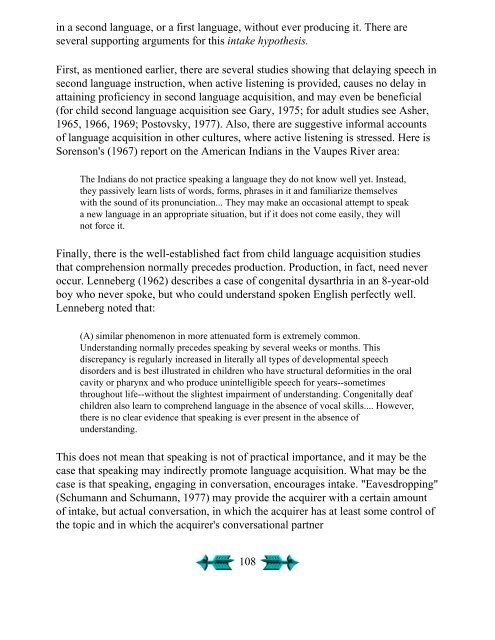Second Language Acquisition and Second ... - Stephen Krashen
Second Language Acquisition and Second ... - Stephen Krashen
Second Language Acquisition and Second ... - Stephen Krashen
You also want an ePaper? Increase the reach of your titles
YUMPU automatically turns print PDFs into web optimized ePapers that Google loves.
in a second language, or a first language, without ever producing it. There are<br />
several supporting arguments for this intake hypothesis.<br />
First, as mentioned earlier, there are several studies showing that delaying speech in<br />
second language instruction, when active listening is provided, causes no delay in<br />
attaining proficiency in second language acquisition, <strong>and</strong> may even be beneficial<br />
(for child second language acquisition see Gary, 1975; for adult studies see Asher,<br />
1965, 1966, 1969; Postovsky, 1977). Also, there are suggestive informal accounts<br />
of language acquisition in other cultures, where active listening is stressed. Here is<br />
Sorenson's (1967) report on the American Indians in the Vaupes River area:<br />
The Indians do not practice speaking a language they do not know well yet. Instead,<br />
they passively learn lists of words, forms, phrases in it <strong>and</strong> familiarize themselves<br />
with the sound of its pronunciation... They may make an occasional attempt to speak<br />
a new language in an appropriate situation, but if it does not come easily, they will<br />
not force it.<br />
Finally, there is the well-established fact from child language acquisition studies<br />
that comprehension normally precedes production. Production, in fact, need never<br />
occur. Lenneberg (1962) describes a case of congenital dysarthria in an 8-year-old<br />
boy who never spoke, but who could underst<strong>and</strong> spoken English perfectly well.<br />
Lenneberg noted that:<br />
(A) similar phenomenon in more attenuated form is extremely common.<br />
Underst<strong>and</strong>ing normally precedes speaking by several weeks or months. This<br />
discrepancy is regularly increased in literally all types of developmental speech<br />
disorders <strong>and</strong> is best illustrated in children who have structural deformities in the oral<br />
cavity or pharynx <strong>and</strong> who produce unintelligible speech for years--sometimes<br />
throughout life--without the slightest impairment of underst<strong>and</strong>ing. Congenitally deaf<br />
children also learn to comprehend language in the absence of vocal skills.... However,<br />
there is no clear evidence that speaking is ever present in the absence of<br />
underst<strong>and</strong>ing.<br />
This does not mean that speaking is not of practical importance, <strong>and</strong> it may be the<br />
case that speaking may indirectly promote language acquisition. What may be the<br />
case is that speaking, engaging in conversation, encourages intake. "Eavesdropping"<br />
(Schumann <strong>and</strong> Schumann, 1977) may provide the acquirer with a certain amount<br />
of intake, but actual conversation, in which the acquirer has at least some control of<br />
the topic <strong>and</strong> in which the acquirer's conversational partner<br />
108











